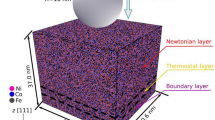Abstract
Vacancies, dislocations, and interfaces are structural defects that are deliberately introduced into solids during grain refinement processes based on severe plastic deformation (SPD). Specific combinations of these defects determine the improved mechanical properties of the obtained ultrafine-grained materials. High-precision, non-equilibrium dilatometry, i.e., measurement of the irreversible macroscopic length change upon defect annealing, provides a powerful technique for the characterization and the study of the kinetics of these defects. It is applied to determine absolute concentrations of vacancies, to characterize dislocation processes, and to assess grain boundary excess volume in pure, FCC and BCC ultrafine-grained metals processed by SPD.

Similar content being viewed by others
References
Feder R, Nowick AS (1958) Phys Rev 109:1959
Simmons RO, Balluffi RW (1960) Phys Rev 117:52
Simmons RO, Balluffi RW (1960) Phys Rev 119:600
Simmons RO, Balluffi RW (1962) Phys Rev 125:862
Simmons RO, Balluffi RW (1963) Phys Rev 129:1533
Hehenkamp Th, Berger W, Kluin J-E, Lüdecke Ch, Wolff J (1992) Phys Rev B 45:1998
Sprengel W, Müller MA, Schaefer H-E (2002) In: Westbrook JH, Fleischer RL (eds) Intermetallic compounds: principles and practice, vol 3. Wiley, New York
Van Ommen AH, de Miranda J (1981) Philos Mag A 43:387
Schaefer H-E, Frenner K, Würschum R (1999) Phys Rev Lett 82:948
Ye F, Sprengel W, Wunderlich RK, Fecht HJ, Schaefer H-E (2007) Proc Natl Acad Sci 104:12962
Pippan R, Scheriau S, Taylor A, Hafok M, Hohenwarter A, Bachmaier A (2010) Annu Rev Mater Res 40:319
Oberdorfer B, Lorenzoni B, Unger K, Sprengel W, Zehetbauer M, Pippan R, Würschum R (2010) Scripta Mater 63:452
Schafler E, Steiner G, Korznikova E, Kerber M, Zehetbauer M (2005) Mater Sci Eng A 410–411:169
Setman D, Schafler E, Korznikova E, Zehetbauer MJ (2008) Mater Sci Eng A 493:116
Cao W, Gu C, Pereloma E, Davies C (2008) Mater Sci Eng A 492:74
Ungar T, Schafler E, Hanak P, Bernstorff S, Zehetbauer M (2007) Mater Sci Eng A 462:398
Zehetbauer M, Kohout J, Schafler E, Sachslehner F, Dubravina A (2004) J Alloys Compd 378:329
Wolf D, Merkle K (1992) In: Wolf D, Yip S (eds) Materials interfaces: atomic-level structure and properties. Chapman & Hall, London, p 87
Steyskal E-M, Oberdorfer B, Sprengel W, Zehetbauer M, Pippan R, Würschum R (2012) Phys Rev Lett 108:055504
Ullmaier H (ed) (1991) Atomic defects in metals Landolt–Börnstein, new series/condensed matter, vol 23. Springer, Berlin
Cahn RW, Haasen P (eds) (1996) Physical metallurgy, 4th edn. North Holland, Amsterdam
Henderson D (1079) J Non-Cryst Solids 30:301
Oberdorfer B, Steyskal E-M, Sprengel W, Pippan R, Zehetbauer M, Puff W, Würschum R (2011) J Alloys Compd 509S:S309
Oberdorfer B, Steyskal E-M, Sprengel W, Puff W, Pikart P, Hugenschmidt C, Zehetbauer M, Pippan R, Würschum R (2010) Phys Rev Lett 105:146101
Acknowledgements
Financial support by Austrian Science Fund (FWF): P21009-N20 is appreciated.
Author information
Authors and Affiliations
Corresponding author
Rights and permissions
About this article
Cite this article
Sprengel, W., Oberdorfer, B., Steyskal, EM. et al. Dilatometry: a powerful tool for the study of defects in ultrafine-grained metals. J Mater Sci 47, 7921–7925 (2012). https://doi.org/10.1007/s10853-012-6460-9
Received:
Accepted:
Published:
Issue Date:
DOI: https://doi.org/10.1007/s10853-012-6460-9




